
Advances and Challenges in Forensic Applications
The Ancient Greeks ate sheep testicles before competitions. Contemporary athletes have designer steroids. What techniques can we use to test our athletes for banned substances?
The Ancient Greek athletes ate sheep testicles before competitions to increase their testosterone levels. Nineteenth-century cyclists used caffeine, alcohol, and cocaine to increase their energy and dull their pain. Contemporary athletes have designer steroids and peptide hormones to build their muscle mass and enhance their performance.
By the middle of the twentieth century, the organizations that regulate sporting events banned participants from using performance-enhancing substances. They created lists of banned substances and founded the World Anti-Doping Agency to test for these substances.
But then comes the hard part. What techniques can we use to test numerous samples in a timely manner?
Koen Deventer of the DoCoLab at Ghent University gave the answer in his presentation entitled, “Detection of Doping Agents in Sports by LC-MS and LC-MS-MS” during the “Advances and Challenges in Forensic Applications of Mass Spectroscopy” session on Tuesday afternoon at Pittcon 2007.
Deventer’s answer is liquid chromatography-mass spectroscopy (LC-MS).
Deventer presented a history of sport-doping detection and believes that LC-MS detection is the future of the industry. He described several LC-MS methods for detecting diuretics, corticosteroids, and anabolic steroids in urine samples. He believes that LC-MS provides analysts with the needed sensitivity, resolution, and speed needed in the anti-doping industry.
However, he pointed out several challenges for anti-doping laboratories such as designer steroids and peptide hormones. These substances have low concentrations in blood and urine, and they are difficult to detect through current techniques. But Deventer is confident that LC-MS will be used further in the continuous battle to stay one step ahead of “cheating” athletes.
Another presentation during the session was entitled “Stable Isotopes in Forensic Chemistry” by Jim Ehleringer of IsoForensics, Incorporated. Ehleringer presented three case studies of how his lab used infrared (IR) spectroscopy to answer adulteration, geography, and manufacturing questions.
Ehleringer presented beer adulteration as his first case study. He used IR spectroscopy to show that beer that is consumed in North America may not be all that barley and hops that we believe it to me.
“Sugar,” Ehleringer said, “is in a majority of North American beers instead of barley.” Ehleringer used the same technique on European beers to discover that beer consumed in Europe is pure barley and not adulterated with sugar.
What’s the difference? “Authenticity laws in Europe,” said Ehleringer. Those laws do not exist in North America, and so beer manufacturers can add whatever they like in order to increase their profit.
So should we start drinking imported beer to get unadulterated beer? No, sorry. European authenticity laws do not cover exports.
Ehleringer went on to show how he has used IR spectroscopy to determine anyone’s residency based on isotope ratios in their hair. Furthermore, Ehleringer’s lab used IR spectroscopy to tie two shoe-bombers together by determining that their explosives where manufactured at the same location.
There were several other presentations in this session that were equally enlightening. The session was arranged by Jehuda Yinon of the Weizmann Institute of Science and Michael Sigman of the University of Central Florida. Sigman was presiding over the session.
Newsletter
Join the global community of analytical scientists who trust LCGC for insights on the latest techniques, trends, and expert solutions in chromatography.





